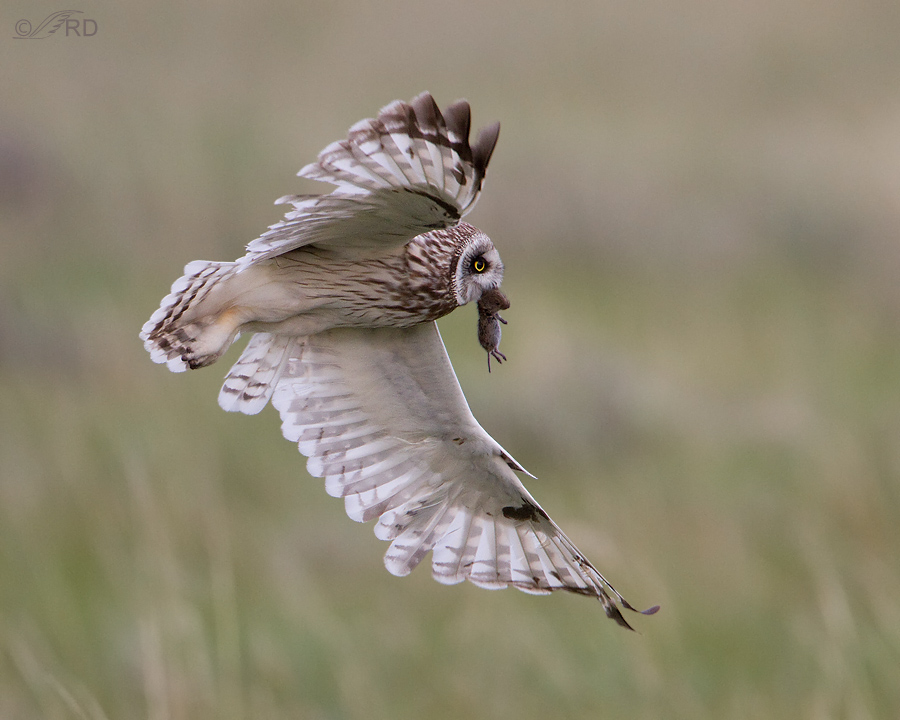This is another image from my time with the Short-eared Owls at Red Rock Lakes National Wildlife Refuge. This male was kept very busy hunting voles and feeding his mate and youngsters at the nest. Typically I would see him hunting far off, dive for a vole, and if he was successful he’d occasionally eat the vole himself but most often he would return with it to a favorite perch in the vicinity of the nest – and without exception he would always carry the vole in his talons before he got to the perch (and always his left talon, but I covered that topic in another post).
1/1600, f/5.6, ISO 800, 500 f/4, 1.4 tc
However, just before (or just after) he took off from the perch to deliver the meal to his family he would always transfer the vole from his talons to his beak. I have a theory as to why he did so.
The nest was on the ground at the base of a sagebrush. Whenever the male landed at the entrance to the nest with the vole the female would rush out and very aggressively grab the vole. And I DO mean aggressively! If I’d been him I’d have been afraid to get that close to her with food. So the male would approach the nest very gingerly with the vole in his beak and drop it in front of him and quickly retreat as she rushed out. I suspect it was easier for him to avoid a confrontation with her if he could quickly drop the vole in front of him rather than have her try to take it away from him while it was in his talons. Just my theory…
It was actually quite comical to watch, especially because the male acted so timid around her.
Ron
*** A note about how I got this image – many folks see a photo of an owl with prey and assume it was baited and in far too many cases they’re absolutely right. I just want to make the point once again that I do not bait – ever! Nor do I do setups or call birds in with electronic devices or any other way. And I don’t use stuffed raptors to lure other raptors into range of the camera. At the risk of sounding self-righteous, in my opinion those methods are used by far too many photographers who portray themselves as nature photographers. To my way of thinking, to do so isn’t ethical and in my opinion such practices produce images that are closer to studio or zoo photography than to nature photography. Besides, those practices often put the birds at risk and no photograph is ever worth that.
Ok, I’m off of my soap box.
Ron



Hi Ron. I am really enjoying your photos. You are fairly new to me–I just discovered your stunning images this passed week. I appreciate your ethics and the fact that you were a teacher, and it shows in your images, camera settings, and descriptions. I have been photographing birds for several years with a Nikon 300mm 2.8 sometimes with TC, on a D300s (difficult–mostly too far away, but sometimes one will fly or land closer). I noticed that noise in my images is strong compared to yours. I understand that in cases where I may underexpose it is to be expected, but even at proper exposures I deal with having to use noise reduction, which can deteriorate feather/image quality. My question is, are you doing ANY noise reduction in post-processing, or is this seriously how the images come out–so smooth with unnoticeable noise? Honestly, with your skill, combined with the feather detail, such as in your short-eared owl images for instance, I can’t stop staring at them. I do hope someday to move up to a 500 or 600mm as well, which may help.
Ron, appreciate your comments re how you get your shots (or not). I am on board with your
beliefs and follow through. Makes appreciating your photography that much better.
Wow. His underside, legs and tarsus look so soft.
Ron,
Great shot. SEO’s are a favorite. I also whole heartedly agree about baiting. Not just with photographing, but birding in general. I am glad you are being vocal about it.
B
Thanks Bryce. I appreciate your thoughts on the baiting thing.
Another truly beautiful shot. Thank you. I am having a down day and I cannot tell you how much this helps.
Thank you Elephant’s Child. Sure sorry to hear you had a rough day and I hope today is a major improvement for you!